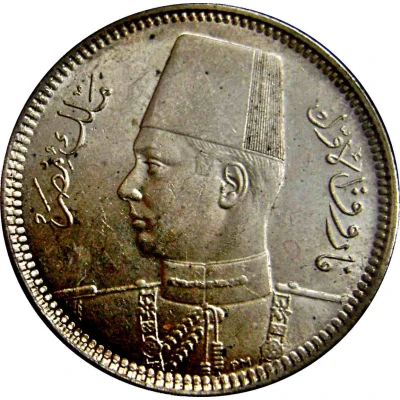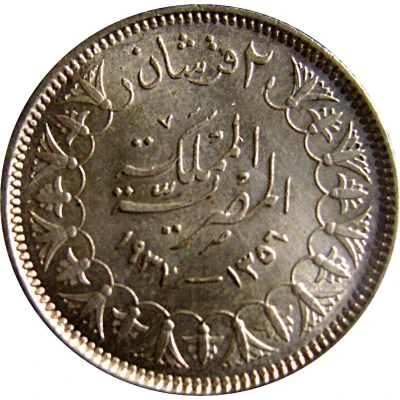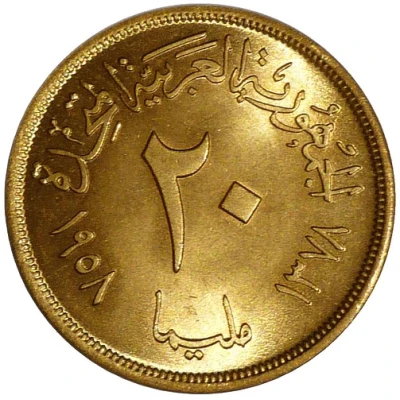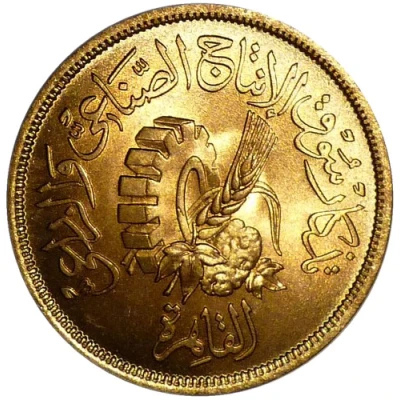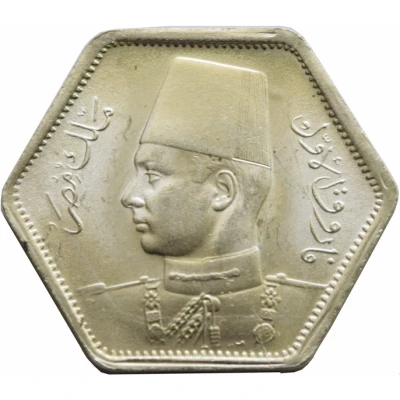
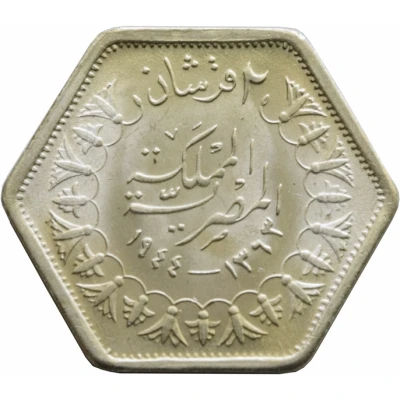

© Joseph Kunnappally
2 Qirsh - Farouk
1363 (1944) year| Silver (.500) (50% Silver, 48% Copper & 2% Manganese) | 2.8 g | 21 mm |
| Issuer | Egypt |
|---|---|
| King | Farouk I (1936-1952) |
| Type | Standard circulation coin |
| Year | 1363 (1944) |
| Calendar | Islamic (Hijri) |
| Value | 2 Piastres (0.02 EGP) |
| Currency | Pound (1916-date) |
| Composition | Silver (.500) (50% Silver, 48% Copper & 2% Manganese) |
| Weight | 2.8 g |
| Diameter | 21 mm |
| Thickness | 0.7 mm |
| Shape | Hexagonal (6-sided) |
| Technique | Milled |
| Orientation | Medal alignment ↑↑ |
| Demonetized | Yes |
| Updated | 2024-10-04 |
| Numista | N#8677 |
|---|---|
| Rarity index | 8% |
Reverse
Arabic legend within decorative pharaonic wreath
Script: Arabic
Lettering:
٢ قرشان
المملكة
المصرية
۱۹٤٤ - ۱۳٦۳
Translation:
2 Piastres
Kingdom
of Egypt
1944 - 1363
Edge
Plain
Comment
Krause lists the mintage as 32,000 only, however, it's believed to be a typo with the actual mintage being 32 million instead of 32 thousandDue to the staggering silver prices during WWII, many countries had to alter their silver coinage, in fact, many countries had to change all of their coinage, namely due to skyrocketing metal costs. Egypt had been using the same dimensions & alloys for silver coinage for 100+ years and the rising silver price due to the War, the silver content of the circular 2 piastres coin surpassed the face value, this leading to many cases of hoarding and smelting to gain material. The government took action, banning all resale of 2 Piaster coins and smelting for material. A new coin with a new alloy of .500 Silver (old alloy : .833) was minted with a new shape to be easily identifiable from the old 2 piastres and was minted in massive quantities to fulfill National silver (silver here means coinage not Ag) needs for many years to come.
It was inevitable that coins’ materials would eventually degrade into base metals. This would later happen in the UAR (United Arab Republic) Era with the 5 & 10 pt.
Interesting fact
One interesting fact about the 2 Qirsh - Farouk 1363 (1944) coin from Egypt is that it was made of a unique silver alloy, consisting of 50% silver, 48% copper, and 2% manganese. This composition was specifically chosen to create a durable and resistant coin that could withstand the wear and tear of daily use. The use of manganese in particular was a deliberate choice, as it helped to strengthen the coin's resistance to corrosion and oxidation, ensuring that it would remain in circulation for a long time. This coin's unique composition makes it stand out among other coins of its time and adds to its historical and numismatic significance.
Price
| Date | Mintage | VG | F | VF | XF | AU | UNC |
|---|---|---|---|---|---|---|---|
| 1363 (1944) | 32000000 | - | - | - | - | - | - |
Values in the table are based on evaluations by sales realized on Internet platforms. They serve as an indication only for 2 Qirsh - Farouk 1363 (1944) coin.
